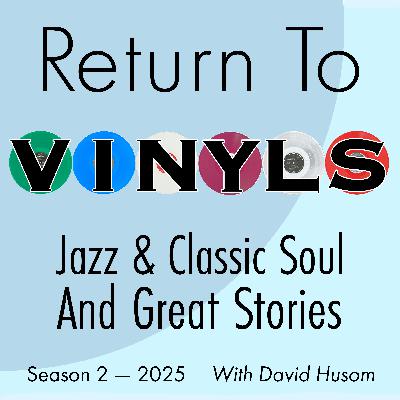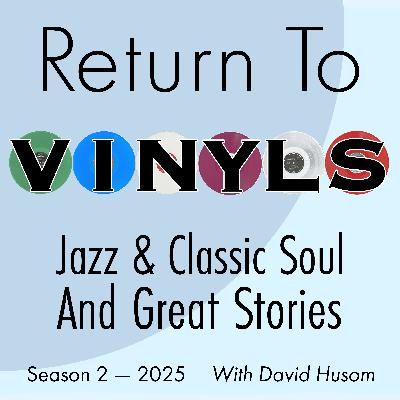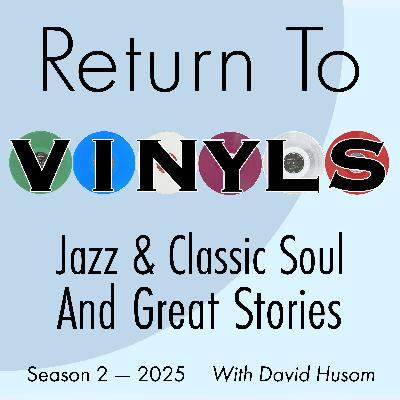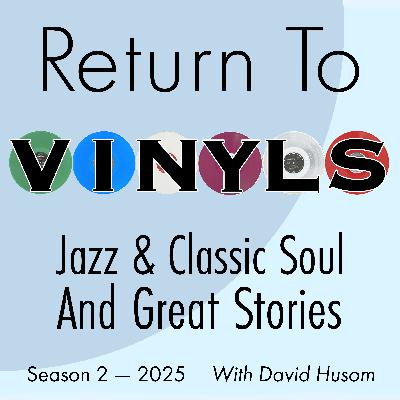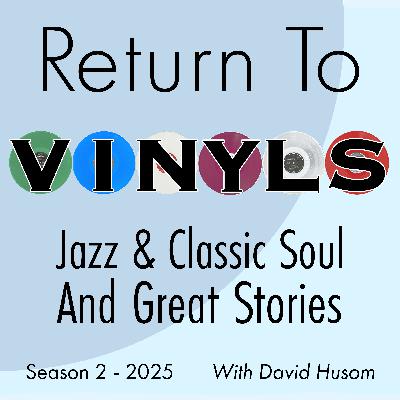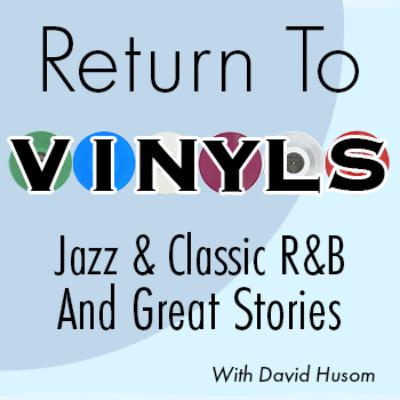Discover Return to Vinyls
Return to Vinyls

Return to Vinyls
Author: David Husom
Subscribed: 1Played: 1Subscribe
Share
© David Husom
Description
Return To Vinyls Podcast focuses on what makes the great music that we love from Jazz and R&B artists and the stories behind the creation and the creators. As a working visual artist and retired professor in Art, Journalism and Liberal Studies host and creator David Husom has spent his life surrounded by creative people in the arts. He brings that perspective of the creative process. The podcast goes beyond just music—looking at the process and work that goes behind creating music and art and the history of the music industry. It is more than just another record review podcast and website.
24 Episodes
Reverse
In 1971 the African country of Ghana hosted a musical celebration called the “Soul to Soul Festival.” It is often referred to as the “Woodstock of Africa.” Although the festival was to honor the tenth anniversary of an independent Ghana, the Festival not only introduced American soul, R&B and modern jazz to the African continent, but the concert had a profound effect on the American musicians who played there that weekend; including jazz pianist and vocalist Les McCann, accompanied by saxophonist Eddie Harris. They had recently crossed over to success with a politically tinged soul music hit. And a young singer recently discovered by McCann, who was on the cusp of having her first major hit, Roberta Flack.Both McCann’s and Flack’s unreleased early work has been issued in the past two years to glowing reviews from the music press. (More on Roberta Flack’s two early albums and her music in Season 2 Episode 12 coming soon) But along with fronting a very traditional modern jazz trio, McCann was starting to explore jazz mixed with soul and politics. With a concert at a Swiss jazz festival he turned the jazz world upside down and created an anthem of 1960s protest that is still relevant today.
Miles Davis was a true jazz lovers — jazz musician. Well, if the criteria is that he was never very popular with mainstream music buyers. Unlike other jazz greats like Louis Armstrong, Stan Getz, Dave Brubeck and Cannonball Adderley, Miles Davis never had a hit record in spite of releasing 57 singles. He had just a few albums that charted in the top 100. So no, Miles Davis never crossed over into popular music circles. Supposedly, you have to really know something about jazz to understand his music. Which is too bad because he did record a whole heck of a lot of accessible music. And he did create the best selling jazz album of all times. Sure there are all these categories when looking at Miles: Bebop, Cool Jazz, Hard Bop / Post Bop, Modal jazz, Jazz Rock / Fusion and orchestral / third wave music. But in the end they are just names. What matters is the music. And Miles Davis produced some truly great music. And amongst the best of the best is Kind of Blue, that five times platinum album.
Think you are not a fan of jazz, think Miles Davis has nothing to offer you? Davis, during his 45 plus year career, released at least 60 studio albums and 39 live albums, as well as 46 compilation albums, 27 box sets, and 4 soundtrack albums. He reinvented himself almost as often as he changed his socks (well at least every few years anyway). Starting in the 1940s there was a move away from big band swing with Be Bop. He then moved on to cool jazz - he was there for the birth of the cool. Then in 1959 he redefined jazz, moving from chord changes to modes - he was the guy who did it first. But in the 1970s he moved again. This time to electric jazz or fusion - he was one of the creators. After a nearly seven year hiatus of not recording or performing he returned playing popular songs of the day including Cindy Lauper and Michael Jackson numbers. He even impressed the master of funk himself - Prince. Return to big bands - sure he did that too. Mix jazz and hip-hop. He was not just sampled but created his own hip hop inspired sounds. So there certainly must be something in there that you can swing to, bop to, rap to, grove to, or just lay back to. Yes because Miles at his best was often laid back and he could be downright mellow.
Memphis based Stax recording star soul singer Johnnie Taylor is probably best remembered today for his R&B hits. But very few crossed over to top 40 radio. So unless you are an in-depth fan of Stax records hits from the 1960s or perhaps a follower of vintage disco you probably do not know much of his catalog of soul and blues and his dance disco hit. It is odd sometimes that artists are remembered for just one or two things when they had relatively successful lifetime careers. There is no doubt that Taylor was a talented singer. He was often compared to his friend Sam Cook and his label mate Otis Redding. Although success seemed to overlook him compared to the superstars of soul music his music is making a comeback and he is finally getting more of the attention he is so deserving of.He did achieve a record industry milestone. He was the first artist to be verified for selling over two million copies of a single song. For an artist to achieve that kind of success must be appreciated for being in touch with the musical cultural zeitgeist of a time period. Let's be honest to have a hit is no small feat. And Johnnie Taylor may not be a household name outside of R&B, Blues and Soul music but he did have hits. Along with recording the first 2X Million seller Platinum record, he also had an R&B hit that did cross over and it is still played to this day. And when you hear it you very well might recognize it. It is one of many recordings he made before sliding out onto the discotheque dance floor. And that journey from the blues to disco is a great story.
If you know anything about the American singer Nina Simone it is probably her deep rich voice singing jazz, blues, soul and popular songs. She often wrote and sang songs for, and about, the civil rights movement. But she also took old standards and popular songs of the day and managed to turn those into civil right anthems as well. But she never studied voice and she never really sang publicly until she turned professional and got her first gig playing piano in a casino-bar. Her wish was to became a classical pianist. She started playing and studying piano at a very early age and her teacher set up concerts of Simone and saved the money in a fund for her to study music in college once she finished high school. But when she didn't get a scholarship to study music any further she turned to jazz and the blues. Since Nina Simone from a very early age wanted to be a classical musician she would not have bothered to study voice in the same seriousness she took to playing the piano. Yet the only job she could get was as a singer. In the end she became much more well known for her voice than her piano playing. Which is a shame, because she was a first class pianist in any musical genera. But it would also be a shame to ignore her powerful voice which reflected the tumultuous era she emerged from.
Even if you are not a country western fan you probably know who Waylon Jennings is and very well might know his song "Bob Wills Is Still The King." So who was Bob Willis you may wonder? He played violin and lead the group Bob Wills and His Texas Playboys. He was known as the king of Western Swing which birthed the Western side of Country Western. And that Western Swing music is rooted in the blues and in jazz. Even Ornette Coleman played with him early on. Yes the Bebop player and founder of the free jazz played Western Swing with Bob's Texas Playboys!
So what is gospel music? Google’s AI says that gospel music is a style of Christian music that originated in African American communities. It’s characterized by rhythmic, spiritual melodies and harmonies. Gospel music often includes call-and-response, group singing, and refrains. Oxford dictionary adds that gospel music is about the teachings of Jesus,According to the Smithsonian, the great Mahalia Jackson was known as the “Queen of Gospel Music.” One of Mahalia Jackson’ earliest recordings Move On Up A Little Higher from 1947 is in the National Recording Registry. Meaning it is seen as a significant song and recording in the history of American recordings. But it does not have harmony, call and response or a group or choir. It is just her, a piano and organ and almost sounds more like the blues than church music. But if indeed she was the queen, and yes she was, then we will say it is gospel because a gospel singer sang it. Hank Williams is primarily thought of as a country western singer. But Williams like Elvis did do gospel songs. His I Saw The Light being a great example. So white, rural, country western, no choir, no preaching can still be gospel as well. Therefore gospel seems to be a much broader term than Google or the dictionary would have us believe. So if country and blues can be gospel did the Rolling Stones sing gospel? Yes they did. They covered an old gospel song originally recorded by the Staple Singers. The lines defining musical genera are often not very clear when you start looking closely at the last 70 years of popular music. Yet, few singers have expanded what gospel music could be, and along with it expanded all of popular music, than Pops Staples, Mavis Staples and the Staple Singers. Their music went from gospel to folk to soul to funk often all at the same time.
I think when most people hit the jackpot, they go out and buy their lottery dream-home and live happily ever after. Well we know from studies that winning the lottery or striking it rich does not always end up well down the road. But you get the point. You win and you are free to do absolutely nothing. Why work when you don’t have it. However, for many if not most artists, no matter how successful they get, they don’t stop —they keep on working and keep pushing boundaries even it means more pressure and yes, more work. They do it because they have to. For them there is no alternative to their making art or playing music. Their creativity needs an outlet and they are so busy they can’t stop.Dave Brubeck found himself in that position in 1967. He ended the very successful classic Dave Brubeck Quartet but less than a year later he has an all new quartet and was back touring and recording new material. Not only that but he started doing what he had rarely done before, he dived into the blues, the roots of all American music from jazz and rock to rap and hip-hop to country western.And what are the blues anyway? This episode looks at exactly how the blues are defined musically.
There are some musicians and artists who regularly reinvent themselves. The Beatles did it right up to their final album. Bob Dylan has done it so many times that in I’m Not There the 2007 film inspired by his life and music, six different actors played his various periods. The reality is that most artists are lucky to get one hit during their career. So what about those that sustain themselves year after year and have careers that last not just weeks or months but decades? Artist’s early in their career need to have a portfolio with multiple ideas and influences to draw from that can be used to generate new work moving forward.
Bonnie Raitt has recorded 18 studio albums, and a few additional live albums, covering a fifty plus year career. She has netted over two dozen Grammy nominations and over a dozen wins including a Lifetime Achievement Award. She is in the Rock and Roll Hall of Fame and recently received the Kennedy Center Honor. Obviously she is an artist who has something to draw from. She did it all by combining the blues, with covers — or more often interpretations of other song writers, writing her own songs and always looking for songs that bring you in and tells you a story. She is still going strong — And she did it on her terms.
In the 1960s and 70s thanks to the explosion in new FM radio stations and the popularity of records, political songs that might have been too controversial for Top 40 radio became part of the soundtrack for a generation. But sometimes what are seen as political songs, and even so called protest songs, really weren’t meant to be political to begin with. Some songs that were meant to be political were not seen as such when they were popular. And songs like Yankee Doodle, Dixie, or This Land Is Your Land that once were very political as time passes become—just songs instead.
So what is a political song anyway? Gil Scott-Heron wrote songs and poetry in response to current events, not just in Black America, but all of America. Are they about politics or are they about culture? Or are they not one in the same now? Why does his work still seem to resonate today?
The song Green Onions by Booker T and the MGs is without doubt one of the major rock and soul instrumentals to come out of the 1960s. According to a review on AllMusic.Com it is “one of the most popular instrumental rock and soul songs ever.” The song is based on a classic twelve-bar blues progression fused with jazz and features Booker T. Jones on Hammond organ, Al Jackson Jr. on drums, Steve Cropper on Fender Telecaster guitar and Lewis Steinberg on bass guitar. The four, particularly once Donald "Duck" Dunn took over bass duties, they were the classic Booker T and the MGs. Add the Memphis Horns and they were the Mar-Keyes. But more often than not, they were the uncredited house band. But together or individually they were the backbone of Memphis soul music. They were not just the musicians playing behind the soul stars — they helped write, arrange and produce many of the Stax hits. They cooked with more than just Green Onions. If it was on Stax Records they were probably there playing.
Return To Vinyls Season Two is coming in January with more R&B, more soul and more musicians that defied easy categories. And of course more great stories behind the music and the creative music makers. Look for us on your favorite podcast host.
She’s been called the godmother of rock and roll. Rolling Stone Magazine named her the 6th greatest guitarist of all time in 2023. If you saw the Elvis movie. Yep, she was in there. The British singer Yola played her singing Strange Things Are Happening Every Day at a club. Elvis was a fan, as the movie depicted. Keith Richards of the band the Rolling Stones has talked about how her European concert tours in the early 1960s influenced British guitarists. She was often called the Swinger of Spirituals — yes she did gospel songs. But it was her electric guitar playing that revolutionized music. Oh and by the way she was featured on a US postage stamp in 1998 from a series honoring early gospel singers. Of course she is clutching her electric guitar on the stamp. Sister Rosetta Tharpe.
Humans have been transfixed by the night sky, well, since the beginning of human existence. There’s ancient rock art and cave art that depicts celestial events and structures that align with the solstices or equinoxes. The stars in the sky tell stories from the American Indian and Australian Aborigine oral traditions, to the ancient myths from Greek, Roman and Arab cultures. They at times overlap from cultures separated by thousands of years and thousands of miles.
There are monsters, Cassiopeia, a queen held captive by the sea god Poseidon, her daughter Andromeda was chained to a rock and only saved at the last minute from being killed by Cetus the sea monster when Perseus cuts off the snake filled head of Medusa and used it to stop the monster. Yep, some strange stuff.
No wonder the sky has attracted artists and storytellers. But of all of the musicians who have written or sang songs about the sky, and there have been hundreds, only one is actually from outer space. His name is Sun Ra and he is from the planet Saturn. And even if his coming from another planet is a bit debatable, this stuff really is pretty out there.
Do you ever wonder why a particular song becomes a hit? Or a best selling book, blockbuster movie, or why a newly emerged visual artist will have work on display or one person shows at major museums all around the world at the same time? As you might guess people have studied that phenomenon.
If you are going to study creative success, music is a good place to begin and we will look at a recent study that does just that. There are a known number of record companies that have produced hits. There are databases like Discogs that list virtually ever record and CD ever made, and of course Billboard magazine quantifies hits each week with the Hot 100 as well as Jazz, R&B, Easy Listening and Country Western songs on dedicated charts. Originally using record store sales, radio and jukebox plays, these days downloads and streaming are added to the mix. Although getting on the top 100 matters a lot and makes it a hit. People following Billboard look even closer at the top 30 and that all important top 10. If you are in the top ten you have made it to the big time. You are in that rarefied world where only the top 20% of hits go.
It is not uncommon for a song to “cross over” from one chart to another. So it may be a hit on the Country chart and also the Hot 100 popular chart. But rarely does it place as high on the second chart. It is very rare indeed, but sometimes you get a Jazz record that crosses over to R&B and also the Hot 100. The Ramsey Lewis Trio did just that by covering a successful R&B record and actually made it into an even bigger hit.
As WWII was drawing to a close in the mid 1940s America’s musical taste was changing and along with it musical venues were going through an upheaval. Dance halls and ballrooms saw audiences abandon once crowded dance floors for a listening experience. But by the 1950s music and venues were changing again. Music in general, and jazz in particular was seen as more sophisticated thanks in part to magazines like Esquire. Therefore jazz stated moving to college campuses and even the most discerning and storied classical music halls.
The jazz pianist Dave Brubeck and his wife Iola Brubeck were amongst those driving that change. But it was not always a smooth road ahead. There were few places in America that were more integrated than jazz groups in the 1940s and 50s. And therefore that road had more than a few speed bumps and potholes. The Brubecks found that out when they tried to schedule a concert tour of 25 Southern colleges in 1960—with an integrated band.
A recent album from Brubeck Editions, Live From The Northwest, 1959 recorded in Portland Oregon added another college concert to the four college concert albums the Dave Brubeck Quartet had previously released. Ironically this concert was in effect a rehearsal for that Southern colleges tour. Additionally from Brubeck Editions there is Live From Vienna 1967 from the Quartet’s final European tour featuring the Dave Brubeck Trio at the famed Vienna Konzerthaus. Trio? I bet you thought they were a quartet? It created a unique concert experience. And both albums are part of really interesting stories that tell us a lot about jazz, culture and history.
The Late Brazilian jazz pianist and band leader Sergio Mendes, who passed away this month, was best known for fronting the Bossa Nova group Brazil 66 who had there first big hit with the Brazilian song Mais Que Nada sung in Portuguese it more or less translates as "Much of Nothing." It was great to see and hear all the tributes to Sergio Mendes and his music. But I was flummoxed that there was never any mention of his truly breakthrough group Brasil 65. Yes before Brasil 66 there was Brasil 65 and for me they were the most exciting and authentic musicians doing Brazilian jazz at that time.
This is a special episode of Return To Vinyls. Remembering Sergio Mendes. Before his breakout recordings with Brazil 66 there was Brazil 65 and it is every bit as good.
This episode is dedicated to James Green, audio artist and friend who also was a fan of Sergio Mendes. We saw Brasil 66 in concert together. My experiences with Jim have been a constant flow throughout much of this series of podcasts. Rest in peace brother.
You need to look no further than the album cover from a new release from British jazz musician Matthew Halsall to know that art and nature both play a critical part in his work. His LP An Ever Changing View has to be one of the most beautiful vinyl packages ever produced. The two record set doesn't stop there, it also contains some really interesting music as well.
Along with art his other non-musical influence is the natural world. His music is a blend of jazz and deeply meditative influences that’s in tune with the natural world. In fact he wrote much of the album while staying in a house overlooking the North Sea in England.
There are artists and writers that create works about nature but there are also others who use nature as a jumping off point. But what about musicians? We can go back 300 years and see, how yes even then, nature played a part in the creation of music. And it still does today.
Do we need yet one more album of someone playing their favorite Beatles hits? When it is Brad Mehldau yes we do. One of the world's top jazz pianists — rated among the top five on National Public Radio and winner of the Downbeat Magazine Reader's Poll eight times, has delved into a few Beatles songs in the past. But this time he jumps in with both feet and the results will surprise and impress you. So what is it about the Beatles and their songs anyway? We will find out from someone who was there. At least in front of the TV during their first American visit and in the stadium during a concert — the only American Beatles concert to not sell out. They hated the town and said they would never come back! Let's look at Your Mother Should Know: Brad Mehldau Plays The Beatles.
Marvin Gaye is certainly a well known Motown star. You may know a bit about the tragic story of his life and death. But you probably do not know all the details and the struggles he went through. Nor the vast catalogue of his many hit records. Add to that all the changes Gaye’s music went through as American society changed in the 1960s and 1970s.
And I bet you have never heard any of R&B singer David Porter’s albums on Stax records. Which is amazing because you no doubt do know his songs. But the man could do much more — he could turn bubble gum into soul! We look at exclusive releases of a classic David Porter from Vinyl Me Please and a new release of a complication of Marvin Gaye’s best sellers from Target


